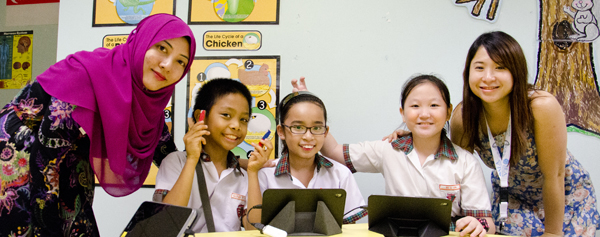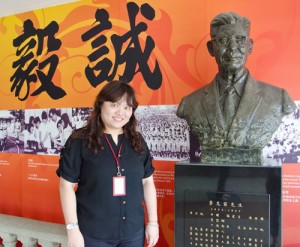Why Singapore’s English Teachers Should Embrace Singlish, Not Fight It
Is it time for Singaporean educators to embrace Singlish as a legitimate learning tool? What the Research […]
Read More
Would too many cooks spoil the broth? Not when it comes to scaling up an intervention! Beginning and experienced teachers from six schools, researchers and Education Technology Officers from MOE all got down to work to see how they can spread the use of technology in inquiry-based learning.
Learning is an important part of being a teacher. And much like students, teachers learn more when they collaborate with others.
Nan Chiau Primary School had a promising intervention on their hands. Good ideas are meant to be spread, and they did just that, by working with five other schools in a North Zone cluster to scale it up, which includes Xishan Primary School.

(from left) Razinah Abu Bakar, Cloud Borja, Simon Diane Clarice, Su Li Xin and Amanda Tan believe that using the tablets make their Science lessons more meaningful
Can 40 pupils all actively participate in class and still be heard at the same time? With technology, the answer is yes!
In inquiry-based learning, teachers do not just provide information and facts to their pupils. Instead, pupils take the lead in their own learning: They collaborate, discuss, rationalize and vocalize their answers.
This is where technology comes in, to let pupils express themselves in different ways. Teachers can also capture their conversations and answers, and identify any misconceptions pupils may hold.
“In the past, lessons are more teacher-centred,” Ms Jenny Lee, the Subject Head of InfoComm Technology at Nan Chiau Primary, notes. “But after we embarked on this project, we use the smartphones to focus on in-class participation.”
For example, Jenny uses mobile apps, such as Socrative, which let pupils respond real-time to class discussions.
“We go through their responses and ask them to explain why someone gave a correct answer or a wrong one, so that they can elaborate and voice out how they feel about things.”
In the past, lessons are more teacher-centred. But after we embarked on this project, we use the smartphones to focus on in-class participation
– Jenny Lee, Nan Chiau Primary School
Jenny’s pupils enjoy using the smartphones outside of the classroom as well. With an app like MyDesk, teachers are able to set online assignments and assign more than just worksheets.
Nicole Naomi Tan, a Primary 4 pupil in Nan Chiau Primary, especially loves using the Sketchbook section of the app MyDesk. “We were out for an excursion and used the phone to create a digital sketchbook to do an assignment. Then, we submitted it to our teachers on the spot.”
Her classmate Tan Shan Lyn adds that besides being convenient, the app made their learning more fun. “We get to write, draw and include pictures from the Internet!” she enthuses. “Our teacher will also show us her favourite sketchbooks afterwards and we can learn from each other and see how interesting and creative we are in our work!”
Furthermore, with the devices, the pupils enjoyed the classes more because they get to collaborate with their classmates. “Instead of the teacher always telling us that we cannot talk to our friends, we get to interact with them through the apps,” says Nicole.
“Certain skills are being taught in the process as we get them to do different things in class, like presentations and debates,” notes Jenny. “This gives them different ways to learn in the classroom, not just with worksheets or pen and paper. Students get to talk and discuss, vote in polls, or give comments about what their friends draw.”

This intervention is part of the project “Inquiry-based Seamless Learning in Primary Science”, a collaboration between Nan Chiau Primary and NIE researchers like Professor Looi Chee Kit and Dr Wu Longkai. Led by Jenny, the project kicked off in 2008 when Nan Chiau Primary’s in-house research centre first opened its doors.
It started with a pilot Primary 3 Science class, but the intervention was soon diffused to the Primary 4 classes and even other subjects in 2010. In 2013, Nan Chiau Primary’s Cluster Superintendent Mr Loke Chee Peng suggested that they scale it to other schools in the North Zone clusters, and five schools soon joined them in this effort.
One of them is Xishan Primary School. Ms Amanda Tan, the Head of Department (Science), Ms Razinah Abu Bakar and their two other colleagues represented the school for this research intervention.
As part of their professional development (PD), they observed lessons at Nan Chiau Primary and then co-designed their curriculum to incorporate the use of technology.
“We wanted to know how Nan Chiau did it,” says Amanda. “The format of this project first allowed us to be on-site and to see how their teachers implemented it. In the co-design sessions, we looked at how we could adapt it for the profile of our children.”
“When we use the ICT tools in the classroom, it’s not about adopting their platform wholesale,” she continued. “It’s about using the platform meaningfully in our Science classrooms and context.”
As with Nan Chiau Primary, pupils at Xishan Primary are also happy to work with technological devices – tablets, in their case. Primary 3 pupils Simon Diane Clarice, Su Li Xin and Cloud Borja say that the tablets got them excited about learning Science. They use an app called Linoit, where teachers pose questions and pupils would write their answers on sticky notes.
“When the question is too difficult, I will go out of the app and research for the answer,” says Cloud. “And then I learn about it. Sometimes, it’s not even in the textbook.”
When asked if reading her peers’ answers helped, Diane notes: “Yes, I’ll read and think to myself that that’s a better answer, and I should learn from that and change my answer.”
Since Amanda and I co-teach, we give each other feedback after the lessons and make sure we’re on track. It’s a constant source of support.
– Razinah Abu Bakar on supporting each other during the intervention
 The Right Mix
The Right MixBehind every successful intervention, there is a lot of work and people involved. Getting the right mix of people to work together is crucial.
“We have very experienced teachers, beginning teachers, researchers who are very strong in research and pedagogies, and Education Technology Division officers who know the curriculum and technology well,” said Jenny. “This made for a very effective group during PD sessions!”
For example, NIE researchers worked closely with her throughout the project. “As a teacher, sometimes I can’t explain what pedagogy or model I’m using in the classroom, but the researchers can break it down for me,” shares Jenny.
“They’re able to explain the good things we’re doing in class and how it impacts our pupils. This makes me find my job even more meaningful.”
She feels like she has become a better teacher from this experience, especially when she is now able to mentor other teachers.
The researchers were also crucial in getting other schools and teachers committed for this project. “When teachers see the research done on the rise of 21st century competencies and how to engage students, they understand why our project is important,” she explains.
The teachers at Xishan Primary also appreciate working with their colleagues from other schools and organizations.
“Having a mentor and a group to work with really helps,” Razinah adds. “Jenny has done the intervention at Nan Chiau before, so based on what she shared, we didn’t have to reinvent the wheel.”
Within the classroom, the teachers also look out for each other. Razinah says, “Since Amanda and I co-teach, we give each other feedback after the lessons and make sure we’re on track. It’s a constant source of support.”
Jenny agrees that working together can only help the scaling up of the intervention. “Nan Chiau took 5 years from a pilot class to a successful roll-out. We wanted to shorten the learning curve for all the schools based on our experience,” she says.
In the end, she reminds teachers to always keep the students in mind. It’s not just about delivering the content, but also about engaging them. To do that, they may need to step out of their comfort zone.
Working with observers in the classroom, for example, is something that some teachers need to get used to, Jenny says. “But you have to be receptive to what the researchers and your colleagues say. Don’t say you can’t do it – you need to have the spirit of trying!”